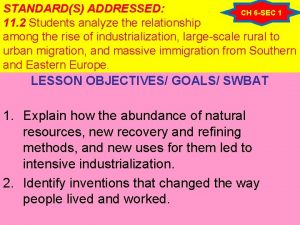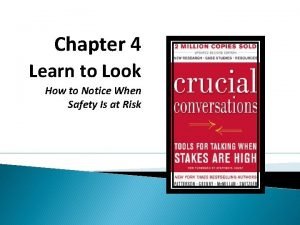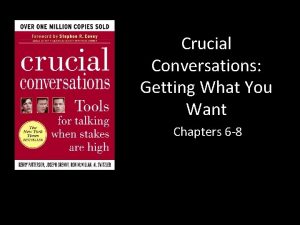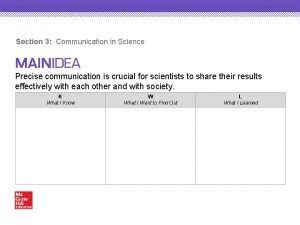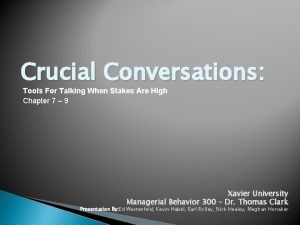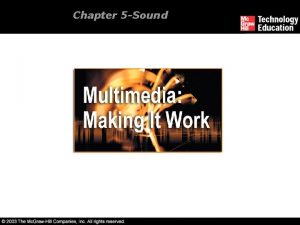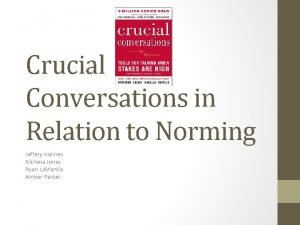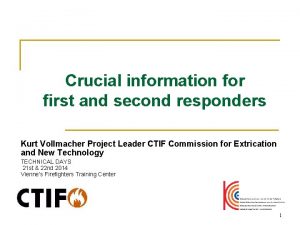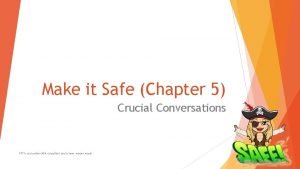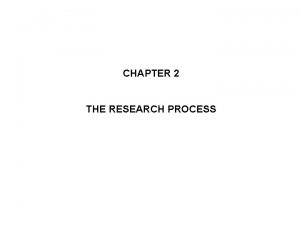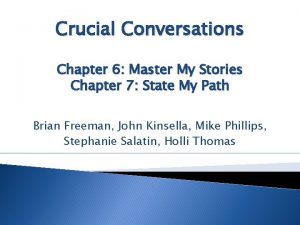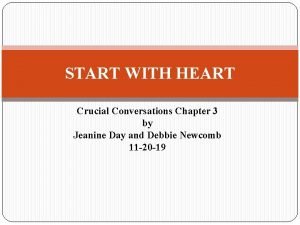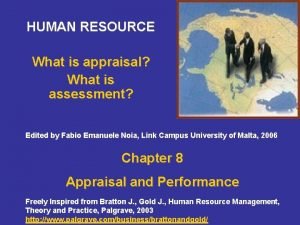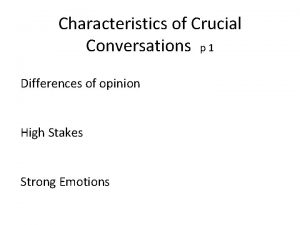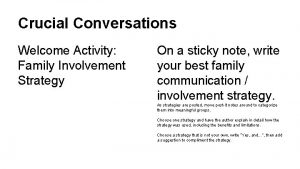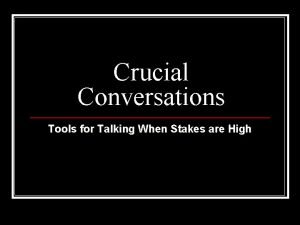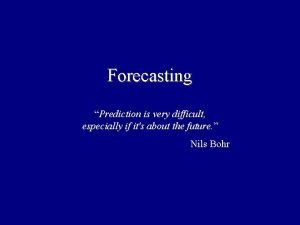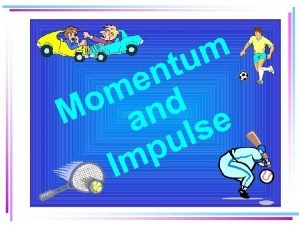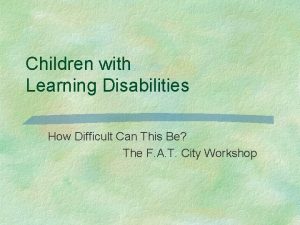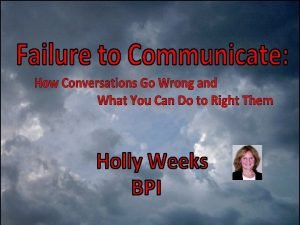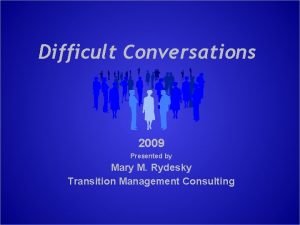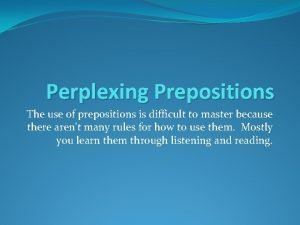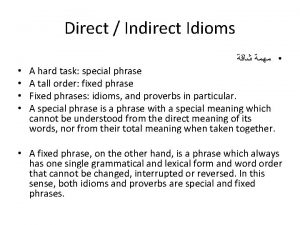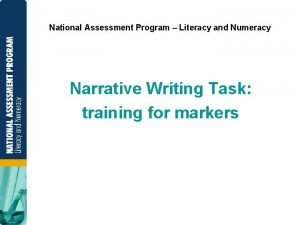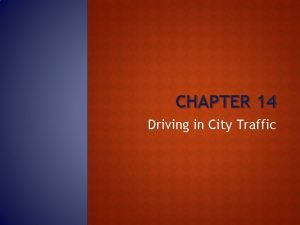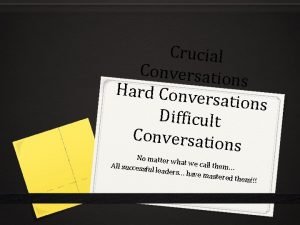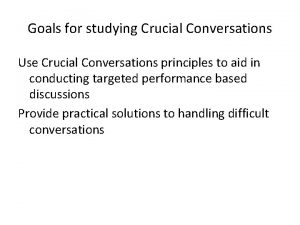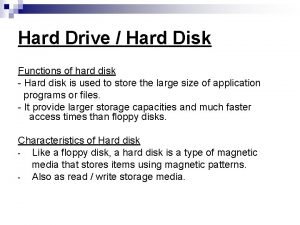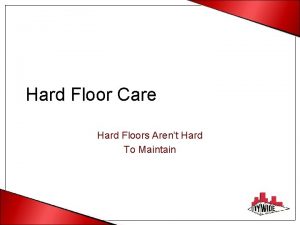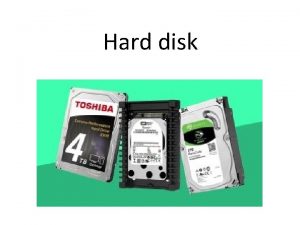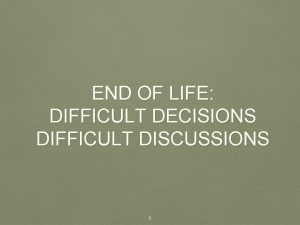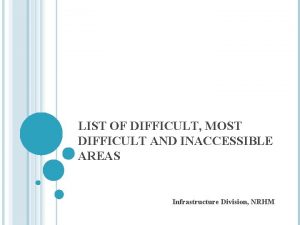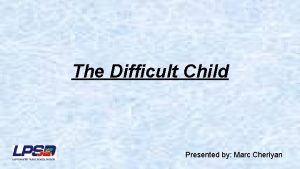Crucial Conversatio ns Hard Conve rsations Difficult Conversatio























































- Slides: 55

Crucial Conversatio ns Hard Conve rsations Difficult Conversatio ns No matter w hat we call t All successf hem… ul leaders… have maste red them!!!

Presenter Information Dr. Mark J. Stock Deputy Superintendent Anchorage School District Elementary Teacher Principal Superintendent 15 years College Professor in Educational Leadership 5 years Hiker, Runner, Fisherman, Hunter Family, two children – soon to be Grandpa

Resources

20 years of research on over 100, 000 people reveals: 0 THE key skill of effective leaders, parents, loved ones… is… 0…the capacity to skillfully address emotionally and politically risky issues. PERIOD!!!!!!

What’s a Crucial Conversation? A conversation between 2 people when… 1. 2. 3. The stakes are high Opinions vary Emotions run strong

Think of One 0 Identify a crucial conversation that meets the criteria 1. The stakes are high 2. Opinions vary 3. Emotions run strong 0 Time permitting – be ready to share without breaking confidentiality 0 Personal / Family / Social / Work / Church etc.

Refusing the “fools choice” 0 Refuse the “fools choice” 0 We sometimes assume that we must choose between getting results and keeping the relationship 0 How can we achieve BOTH?

What’s your style under stress…? 0 Stress Test – 0 In the chat box 0 https: //www. vitalsmarts. com/styleunderstress/ 0 What do you do when the talking gets tough?

Styles 0 Silence 0 Masking 0 Avoiding 0 Withdrawing 0 Violence 0 Controlling 0 Labeling 0 Attacking

Having Har d Conversatio ns Jennifer Abr ams

Why do we avoid hard conversations? (Jennifer Abrams) As a cultural norm, educators are noted for avoiding conflict.

Activity 0 Choose one crucial conversation that you have been avoiding 0 As we go through the 18 reasons we avoid them – write down the ones that apply for you.

1. A desire to please 0 “I want people to like me. ” 0 “I don’t want to look mean. ” 0 Educators are nurturers. Mostly.

2. Personal Safety 0 “My colleague is aggressive and scary” 0 “I don’t want the pain and agony” 0 “I don’t like tears or anger…makes me uncomfortable”

3. Personal Comfort 0 “Confronting this will take too much work. ” 0 “I don’t want to make waves. ”

4. Fear of the unknown 0 The number one value of educators is “stability” 0 Educators will put up with stomach distress, headaches, insomnia and many other ailments – rather than deal with the unknown….

5. No sense of urgency 0 “I will wait until it happens again…” 0 The third times the charm… then I’ll address it. ” 0 Remember – if physical safety, emotional safety, or educationally unsound practices… etc. are involved – it’s best to move with more urgency.

6. I don’t fit in here! 0 The culture here does not meet things head on … why should I?

7. Waiting for the perfect moment. 0 “I cant talk to her until I know more about it…”

8. Perfectionism 0 “I can’t talk to him until I have the perfect words”

9. Distrust of oneself or others 0 “I don’t trust my gut instinct” 0 “ I might be too sensitive”

10. Lack of authority 0 “Who am I to bring it up…I’m not in charge…”

11. Distrusting our own judgment 0 “Who am I to tell someone else how they ought to do their job? ”

12. Fear of kicking someone else when they are down 0 “This will overwhelm him and he’s got enough problems as it is. ”

13. Too big a shift in role expectations 0 Instructional coaches or new supervisors may find the role change to be uncomfortable. Confronting peers or employees without training or experience may be overwhelming.

14. This wasn’t in my job description 0 “I just assumed most people knew the right thing to do. I didn’t know I had to deal with all these things. ”

15. Too close to home 0 “This is a small town. Everyone knows each other. I need to keep this relationship as it is. ”

16. Conflict with beliefs or values 0 “I don’t agree with the decision on this anyway, why should I confront someone over it!”

17. Fatigue 0 “I don’t have the energy to take this on!”

18. Personality or intent 0 “She is really a nice person – I hate to confront her on this. ” 0 “I am sure she didn’t mean it that way!”

The Toll… 0 We feel personally guilty for not addressing it…. 0 We feel fraudulent…as if we are not in the world as we really are” 0 We give control or power to the other person… 0 “It looks to others like we condone their behavior” 0 We don’t live up to our principles… 0 “We feel like a hypocrite” 0 We allow the organization (students, staff, parents, employees…) to experience negative consequences. 0 “Kids and adults get hurt, or don’t receive benefits they should”

When is it appropriate NOT to confront?

Timing Issues 1. 2. 3. 4. 5. 6. Will the problem fix itself? Does it need to be addressed now? Am I in the right frame of mind now? Is this the right time for the other person? Do I have enough information now? Do I prioritize this over other conversations?

Stakes 1. 2. 3. 4. What’s the best and worst that could happen? What is the ripple effect? Do negatives out weigh the positives? Who might need to know before I talk to the person?

Likelihood of Success 1. If I bring this up do I have an action plan? A solution? 2. How promising are the hoped-for results?

Options 0 Are there other alternatives with less risk? 0 Has this person had the opportunity to recognize the issue on their own? 0 If I speak up will it move me closer to my goal or farther away?

Consequences for failure 0 What is the worst that could happen and how likely is that?

Personal perspective 0 Will this be seen as only my issue? 0 Do I model the behavior I am looking for? 0 How do my beliefs guide me to think this way and would other beliefs alter my thinking?

Feasibility 0 Is the solution I am proposing possible for this individual to accomplish or learn? 0 If I bring up the concern is there time to deal with it?

Difficult Conversation Outcome Map 0 What is the presenting problem? 0 What is the tentative outcome? 0 What is the desired behavior you would like to see? 0 What knowledge, skills, attitudes, dispositions or attitudes does this person need to carry out those desired behaviors? 0 What strategies can you use to promote this person’s growth? 0 What resources (internal and external) do you need to carry out these strategies?

How to have a difficult conversation Step 1: Explain the presenting problem to the individual in a concise statement Example – “Thank you for coming in to see me. The reason I wanted to visit with you today is that I noticed you have not been attending your team’s scheduled collaborative meetings. ”

Step 2: Explain the tentative outcome you are after Example “In case there is some confusion, I just wanted to make sure that you know, it is my expectation that you attend your team’s scheduled collaborative meetings. ”

Step 3: Explain the specific behaviors you are seeking from the individual Example: “I expect you to attend the planned meetings and to be on time and prepared. I also want you to let others know if you cannot be there. It is also my expectation that you contribute to the work load of the team in an equitable manner. ”

Step 4: Explain the knowledge, skills, dispositions or attitudes this person needs to meet the desired outcome. Example: “I want you to be aware of the impact this has on others when you are late or absent. Do you recognize the professional role you have with colleagues? Not only can you benefit professionally from their support, but you have skills and knowledge to contribute that I believe they can also benefit from. ”

Step 5: Describe the strategies that could promote this person’s growth. Example: “Just to make sure we are clear, here is the job description and the code of ethics from the staff manual that describes professionalism including the need and expectation to attend collaborative meetings. Is there anything you might need to make sure that the meetings are relevant and helpful to you? ”

Step 6: Describe any resources you might be able to provide for a successful outcome. Example: “Here are some upcoming PLC trainings, and here is a book that many teachers have found helpful when struggling with collaborative teamwork. ”

Step 7: Conclude by asking questions and seeking their understanding or willingness. Then restate your expectation. Example: “How do you see this issue? Is this something you are willing to work on? Is this something you CAN do? ” “It is my expectation that you will attend your collaborative meetings and that you will be a positive contributor. Thank you for working on this and I am confident you be a great support to your team and that they will be able to depend on you. Thanks for coming in. I will touch base again in a few weeks to see how it is going. ”

More tips on holding the conversation 0 Setting the tone: and purpose 0 You must scale your tone and your non-verbals in relation to the seriousness of the conversation. 0 The other person must understand the level of intensity the conversation requires YET you don’t want to show more emotion than is necessary.

Tips 0 Get to the point and name it professionally: 0 As you name the issue “present the problem” from your outcome map. 0 Avoid trigger words (“lazy, chaotic, …) 0 Use professional language that is not judgmental

Tips 0 Give specific examples: 0 Use the most current examples first 0 Don’t give too many at once

Tips 0 Describe the effect on the school, students, parents, colleagues, etc. 0 Explain the impact…

Tips 0 State your desire to resolve the issue and open the discussion 0 End your opening statements by stating the change you would like to see take place and then open by asking questions: 0 How do you see it? 0 How do you feel? 0 What are your thoughts? 0 DO you see this differently?

Preparing the logistics 0 Initiating contact 0 No cryptic voice messages or emails 0 Find a private place and time (remember – the more serious the discussion the more formal the setting) 0 Think about timing. (Do they have to teach after this conversation? ) 0 Body Language 0 Voice: “credible voice” of authority goes down, “approachable voice” goes up at the end of sentences 0 Hands: palms down is business, palms up gives listener an opening 0 Eyes: Not looking means hesitation, too much looking may be too imposing. Consider culture and context.

Last bit of advice “I have so many battles to fight – how do I know where to start? ” Choose one with the most negative effects on your students - but is the easiest to solve. Then move to the next one.

Resources
 Work hard. have fun. make history
Work hard. have fun. make history Hard times hard drive
Hard times hard drive Gravimetric analysis of calcium and hard water lab answers
Gravimetric analysis of calcium and hard water lab answers Which resources played crucial roles in industrialization?
Which resources played crucial roles in industrialization? Crucial conversations learn to look
Crucial conversations learn to look Constructive structure asl
Constructive structure asl Crucial systems
Crucial systems Crucial conversations 7 principles
Crucial conversations 7 principles Crucial conversations chapter 6 summary
Crucial conversations chapter 6 summary Why is precise communication crucial in science
Why is precise communication crucial in science Difficult conversation role play scenarios
Difficult conversation role play scenarios Ampp crucial conversations
Ampp crucial conversations The detective need more time to inquire about the case
The detective need more time to inquire about the case Crucial aspects of preparing digital audio files
Crucial aspects of preparing digital audio files Cruicial conversation
Cruicial conversation Crucial conversations planner
Crucial conversations planner Crucial conversations tips
Crucial conversations tips Crucial conversations
Crucial conversations Kurt vollmacher
Kurt vollmacher Crucial conversations presentation
Crucial conversations presentation What processes are crucial to the ipde process
What processes are crucial to the ipde process Master my stories crucial conversations
Master my stories crucial conversations Crucial conversations start with heart
Crucial conversations start with heart Performance management is crucial to ______.
Performance management is crucial to ______. Characteristics of a conversation
Characteristics of a conversation Crucial conversations triangle
Crucial conversations triangle Talk tentatively
Talk tentatively Forecasting is difficult especially about the future
Forecasting is difficult especially about the future Communicating with difficult people
Communicating with difficult people Why is software difficult to build?
Why is software difficult to build? 332 rule intubation
332 rule intubation Complications of c section
Complications of c section Momentum is a measure of how difficult it is to
Momentum is a measure of how difficult it is to Education outside the classroom
Education outside the classroom Difficult question tags exercises with answers
Difficult question tags exercises with answers Thy thou thee
Thy thou thee How to deal with difficult people
How to deal with difficult people How difficult can this be
How difficult can this be While taking a difficult test cindy muscles
While taking a difficult test cindy muscles English is not so difficult as
English is not so difficult as Why is it more difficult
Why is it more difficult Dealing successfully with difficult changes in your life
Dealing successfully with difficult changes in your life Seas bonus points
Seas bonus points Difficult circumstances seas application example
Difficult circumstances seas application example Thwarting ploys
Thwarting ploys Dealing with difficult volunteers
Dealing with difficult volunteers Difficult conversation preparation worksheet
Difficult conversation preparation worksheet Difficult prepositions
Difficult prepositions Indirect idioms
Indirect idioms Difficult words to spell
Difficult words to spell Stork case
Stork case Why is city driving more difficult
Why is city driving more difficult Tell me all about this name that is difficult to say
Tell me all about this name that is difficult to say The difficult path analysis
The difficult path analysis Hard 최상급
Hard 최상급 Something that is difficult to understand
Something that is difficult to understand



